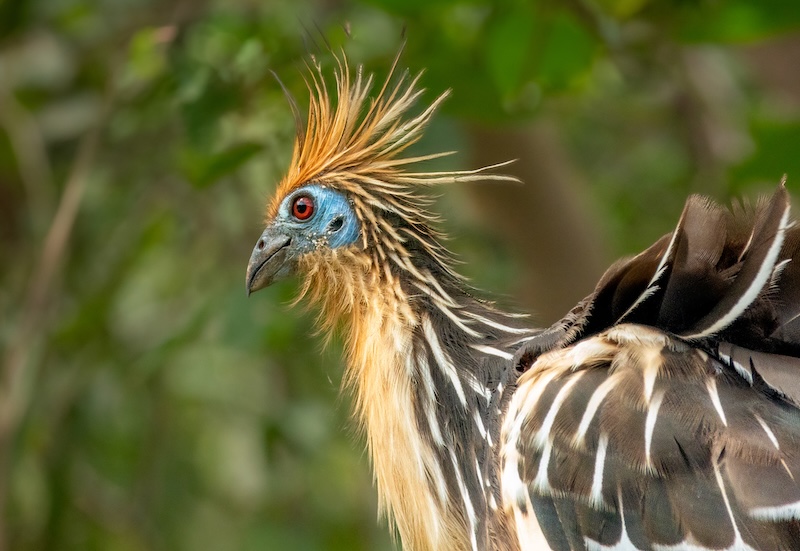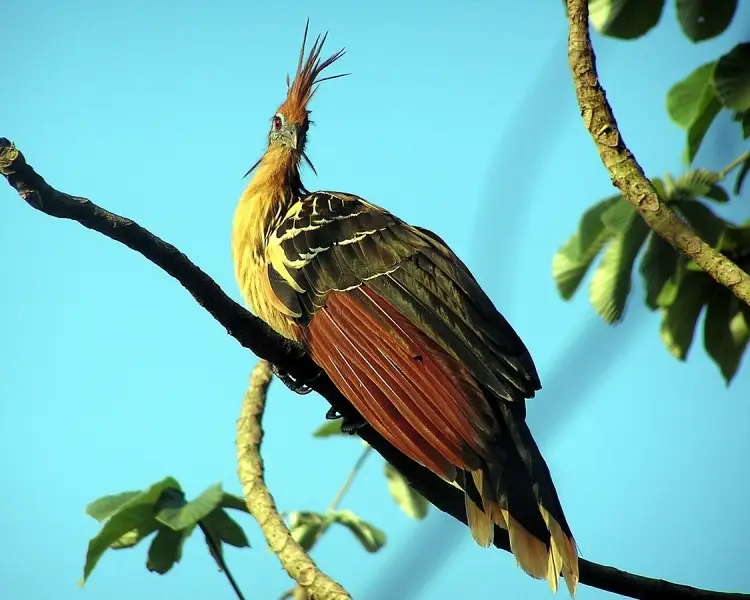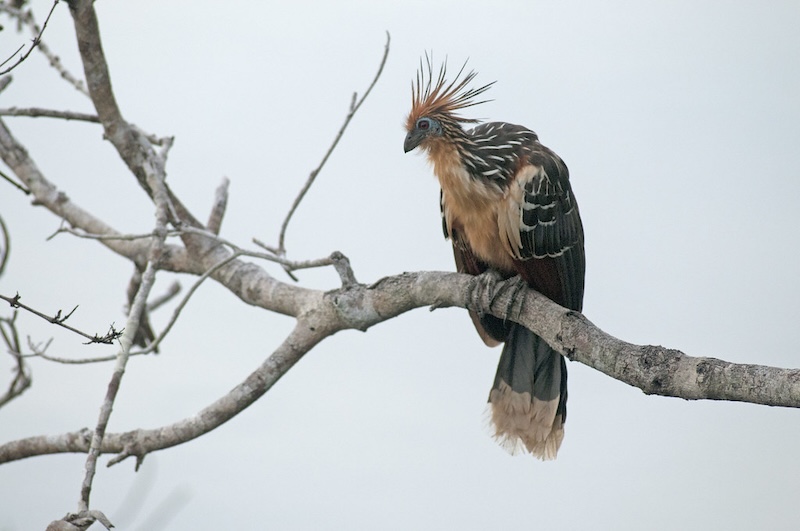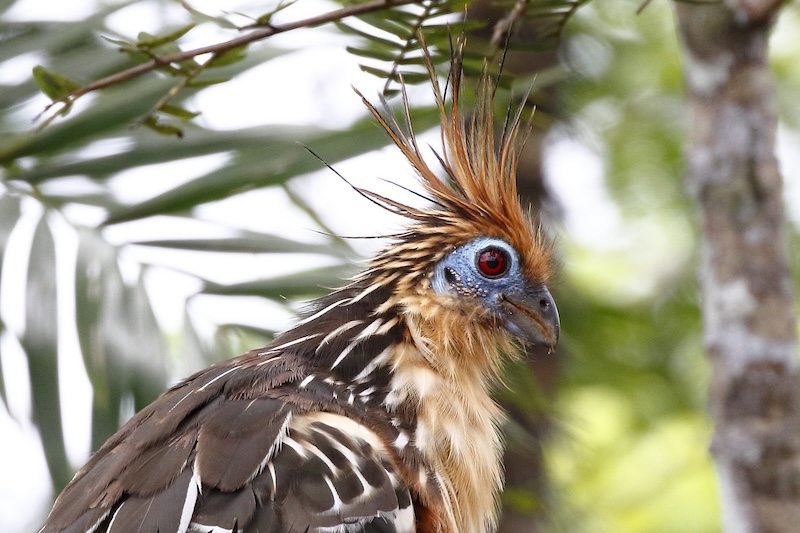The Hoatzin’s peculiar attributes extend beyond its appearance. From its diet to its social structures, every aspect of this bird challenges what is typically known about avian life. As a living link to ancient times, the Hoatzin offers a glimpse into the past. Its continued existence a testament to the resilience and adaptability of life forms in the Amazon. For scientists and nature enthusiasts, understanding the Hoatzin is a journey into the depths of evolutionary biology and ecological interdependence.

The Hoatzin (Opisthocomus hoazin) possesses a distinctive look that immediately captures attention. Often likened to a creature from another era, this bird features a striking mohawk of spiky orange feathers, vivid blue skin around its eyes, and a robust body cloaked in a mosaic of rich browns and blacks. Such a remarkable appearance makes the Hoatzin a standout species in the dense foliage of its habitat. Its vibrant plumage not only serves as camouflage among the forest’s varied hues but also as an intriguing display for birdwatchers and researchers venturing into its territory.
Most intriguing, however, is the Hoatzin’s chicks, which display a feature unseen in modern birds: claws on their wings. These claws are reminiscent of ancient avian ancestors, allowing young Hoatzins to clamber through the trees with ease. This characteristic has earned them the nickname “living fossils,” highlighting their connection to prehistoric birds.
The presence of these claws has sparked debates and studies among paleontologists and ornithologists, aiming to understand the evolutionary paths that have led to the current avian anatomy. The claws not only aid in mobility but also play a crucial role in the chicks’ survival, providing them with the means to navigate their complex environment from a young age.

The Hoatzin thrives in the lush, humid environments of the Amazon Basin, stretching across countries like Brazil, Peru, Colombia, and Venezuela. This bird is often found perched along the waterways and swamps of the rainforest, favoring areas rich in vegetation. The dense undergrowth and towering trees offer both food and protection, serving as the perfect backdrop for their unusual lifestyle. The abundance of foliage in these regions supports their unique dietary needs, while the complex landscape provides ample opportunities for shelter and nesting.
The Hoatzin’s choice of habitat is not arbitrary. The swamps and wetlands provide a bounty of leaves and buds, which are crucial to their diet. Unlike most birds, Hoatzins are primarily folivores, relying on a diet of foliage. This dietary preference has led to fascinating adaptations that set them apart from other avian species.
Their reliance on specific plant species underscores the importance of preserving their habitat, as any disruption to the vegetation could have profound impacts on their survival. Furthermore, their presence in these ecosystems highlights the delicate balance maintained within the rainforest, where each species plays a role in the broader ecological tapestry.

The Hoatzin’s diet of leaves is facilitated by an unusual digestive system, more akin to that of ruminants like cows than birds. This bird possesses a specialized crop that ferments vegetation, breaking down tough plant material with the aid of bacteria. This fermentation process results in a distinctive odor, earning the Hoatzin another nickname: “stinkbird.” The unique digestive mechanism is a rare adaptation in the avian world, setting the Hoatzin apart as a fascinating subject for scientific exploration.
This unique digestive system allows the Hoatzin to extract maximum nutrients from their leafy meals. However, it also makes them rather clumsy flyers. The enlarged crop, necessary for digestion, adds weight and bulk, hindering their ability to soar gracefully through the canopy.
Instead, Hoatzins are often seen clambering and hopping from branch to branch, showcasing their agility in their arboreal environment. This adaptation illustrates a remarkable trade-off between dietary specialization and flight capability, providing insights into evolutionary pressures that shape species over time. The Hoatzin’s lifestyle is a testament to the varied paths of adaptation and survival in the natural world.

Hoatzins are social creatures, often found in small family groups. These birds communicate through a series of grunts, hisses, and croaks, adding to their bizarre charm. Their vocalizations are believed to serve various functions, from maintaining group cohesion to signaling alarm.
The complexity of their communication suggests a level of social organization that is both fascinating and essential for their survival in the dynamic rainforest environment. Through their interactions, Hoatzins demonstrate the importance of social bonds in navigating the challenges of their habitat.
Their social structure is also noteworthy. Hoatzins exhibit a form of cooperative breeding, where older siblings assist in raising the younger chicks. This communal approach ensures the survival of the young in the challenging environments of the rainforest.
Such cooperative behavior highlights the importance of family units and shared responsibilities, enhancing the survival chances of the group as a whole. This system of care and collaboration among Hoatzins reflects broader themes of cooperation found throughout the animal kingdom, offering valuable lessons in the benefits of communal living and resource sharing.

Despite their peculiarities and fascinating adaptations, Hoatzins face threats from habitat destruction and environmental changes. The Amazon Rainforest is continually subjected to deforestation and land conversion for agriculture, which poses a significant risk to the Hoatzin’s habitat. The ongoing loss of biodiversity and natural habitats calls for urgent action to protect these unique birds and the ecosystems they inhabit. The Hoatzin’s plight is a microcosm of the broader environmental challenges facing countless species worldwide.
Conservation efforts are crucial to preserving these unique birds and their environment. Protecting the Amazon’s waterways and forests ensures that the Hoatzin, with all its prehistoric splendor, continues to be a part of our natural world. Collaborative efforts involving governments, NGOs, and local communities are essential to address the root causes of deforestation and promote sustainable practices. By safeguarding the habitats of the Hoatzin and other species, we uphold the integrity of the Amazon’s rich biodiversity, ensuring future generations can witness the wonders of this unparalleled ecosystem.

For those eager to witness the Hoatzin in its natural habitat, the Amazon Basin offers unparalleled opportunities. Guided tours through the rainforest, particularly along the waterways where Hoatzins are commonly found, provide a chance to observe these birds in action. Engaging with local guides and communities enhances the travel experience, offering insights into the cultural and ecological significance of the region. By choosing responsible tourism, travelers contribute to conservation efforts, supporting initiatives that protect the Hoatzin and its habitat.
Travelers should prepare for the humid climate and dense vegetation, equipping themselves with breathable clothing and insect repellent. Binoculars and cameras are essential for capturing the essence of the Hoatzin and the vibrant ecosystem it inhabits. Immersing oneself in the sights and sounds of the Amazon is an unforgettable experience, offering a deeper understanding of the interconnectedness of life within this rich biome. As adventurers traverse this lush landscape, they gain a new appreciation for the intricacies and wonders of the natural world.
The Hoatzin is more than just a bird; it is a living testament to the evolutionary wonders of our natural world. With its blend of ancient traits and modern oddities, the Hoatzin captivates the imagination and inspires a deeper appreciation for the biodiversity of the Amazon. Its presence in the rainforest is a reminder of the complexity and marvels of life on Earth, urging us to reflect on the interconnectedness of all living things.
For travelers and nature enthusiasts alike, the opportunity to observe the Hoatzin in its element is an unforgettable experience. As we continue to explore and document the wonders of our planet, let us also commit to preserving the habitats that sustain such extraordinary life forms. Through conservation and education, we can ensure that the Hoatzin and its fellow inhabitants of the Amazon continue to thrive, enriching our understanding of the natural world and inspiring future generations to cherish and protect our planet’s biodiversity.
In the heart of the Amazon, the Hoatzin awaits, a reminder of the mysteries yet to be unraveled in nature’s grand tapestry. Its story is a call to action, urging humanity to embrace the responsibility of stewardship, ensuring that the wonders of the natural world endure for all time.